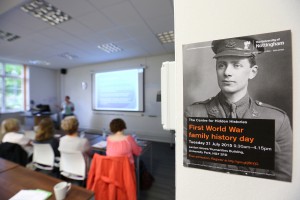In this post, Professor John Beckett outlines the hidden history preserved in a small corner of Northern France
A few miles south of Arras, along a road tucked in behind the village of Ayette, one of those familiar dark green Commonwealth War Graves Commission signposts appears to direct you

to turn left into a hedge. In fact, on closer inspection it turns out to be an unmade lane or track. Being wise after the event, I recommend walking down the track – either that or being prepared for a long reverse since there is nowhere to turn a car around! Two hundred yards or so along the track you reach the Ayette ‘Indian and Chinese Cemetery, 1917-1918’. What on earth, I wondered, was this small cemetery doing in this remote location, and why was it dedicated to Indian and Chinese casualties? Indian we can guess since we know that many troops came to Europe to be part of the Imperial war machine. We may not know as much about them as about the white British lads who we expect to find memorialised on the gravestones of the cemeteries maintained by the CWGC, but we know about their military role, notably in 1915.
But China? Why should any Chinese people have been tied up in this war? World War it may have been, but I do not recall China being lined up on either side of the Imperial divide? Unlike India, it was not part of the British Empire.
So what is the story? As is well known, between 1914 and 1916 the British army grew rapidly in line with the recruitment policy instigated in August 1914 by Lord Kitchener as soon as he was appointed Secretary of State for War. By the eve of the Battle of the Somme the relatively tiny band of regulars and territorials who had been mobilised in 1914 had been transformed into a fighting force of more than one million men occupying almost 200 km of trenches along the Western Front. As it had grown in size and activities, front-line units had been supported with food, ammunition and war materials, largely as a result of the work of the British labour corps and pioneer battalions or combat troops resting from the trenches. These men also built camps, salvaged weapons and munitions from the battlefields, and carried out repairs to roads, railways and airfields. As such, the vastly inflated army was underpinned in order to maintain its pursuit of trench warfare.
All this changed when the Battle of the Somme commenced on 1 July 1916. The casualty rates were such that with a few months there was a severe labour shortage on the Western Front. Every able-bodied serviceman was needed at the front, and the British were increasingly desperate to find fresh sources of manpower. At home this was largely achieved by the introduction of conscription, but in addition to extra soldiers they also needed labourers. Where we these to be found?

In October 1916 the War Office approached the Chinese government, which was then officially neutral. It came up with a plan which led to the formation of the Chinese Labour Corps (CLC). Public proclamations, often promoted by local missionaries, encouraged Chinese men to join the Corps, which was non-combatant but under British military control and discipline. For poor Chinese peasants, particularly those in the cold northern provinces of Shantung and Chihli, pledging themselves to three years of service in return for pay which was far better than they could hope for at home, seemed like a winner. The first transport of Chinese labourers made its way to Europe via Canada at the beginning of 1917. By the end of 1917 there were 54,000 Chinese labourers attached to the Commonwealth forces in France and Belgium. This figure doubled by November 1918.
Meantime, and partly because the British were uncertain about the likely response in China, preparations had been made to expand the existing Indian Labour Corps. Labour battalions of men serving with the Indian Corps had been used on the Western Front since September 1915 but it was only in 1916 that steps were taken towards forming a separate Indian Labour Corps. The civil authorities in the various Indian provinces were asked to start recruitment campaigns and the first Indian labourers arrived in Marseilles in June 1917. By the end of August 1917 over 20,000 workers had arrived in France. At the Armistice the Chinese Labour Corps numbered nearly 96,000 and even in May 1919, 80,000 were at work in Europe.

In the course of 1917 and 1918 men from the Indian and Chinese labour corps undertook transport, maintenance; salvage and construction work on the Western Front and as such made a significant contribution to the Allied war effort. They were mostly deployed beyond the range of enemy guns, and managed by officers of European extraction, many of whom were former civil servants or missionaries who were able to communicate with the workers but had little or no military background. Even so, many of the Chinese and Indian Labour Corps died as the result of long-range shelling, air raids, and enemy action during the German Spring Offensive in 1918. Others fell victim to illness, particularly Spanish flu through the winter of 1918-19. In total around 2,000 Chinese and 1,500 Indian labourers died while serving on the Western Front.
The Indian and Chinese cemetery at Ayette was set up by British troops in September 1917 and used until April 1918. However, Ayette was the scene of heavy fighting in March 1918, and the village was captured by German troops during the offensive. If was retaken by the 32nd Division on 3 April 1918 and remained in Allied hands thereafter. Interments at Ayette resumed in autumn 1918, and although the cemetery claims on its perimeter wall to have burials from 1917-18 it contains a number of later burials from 1919. The cemetery has a lovely little pagoda. It holds 109 members of the Indian Army, 42 men of the Indian labour corps, 33 men of the Chinese labour corps, and one German interment (Heinrich Vodische). It has the full range of inscriptions the Imperial War Graves Commission agreed with the Chinese for their graves, including ‘A Noble Duty Bravely Done’, and ‘A Good Reputation Endures Forever’. The gravestones are a mixture of English and Chinese or Indian script.[1]

Some labour corps units remained in France after the Armistice to help with the clearing of the battlefields, which largely meant the exhumation and re-interment of thousands of Commonwealth soldiers in nominated cemeteries. How many of the Chinese Labour Corps subsequently made their way home is unclear. Apart from those who died, it seems likely that many remained in Europe.
[1] Rose E.B. Coombs, Before Endeavours Fade (2010), 100


 Hidden is, of course, a relative term. The IWM’s ‘Lives’ project is all about ‘finding’ the 8m or so men and women who were directly involved in the First World War. The records exist for many of these, but there has not been a previous attempt to bring the material together and to create individual profiles of each one, in a single place. The IWM’s project, ably discussed by Charlotte Cyzyzk, is an attempt to do just that, and to make sure that no one who played a substantive role, whether they were at the Western Front, whether they were killed, maimed, or escaped Scot free, is omitted. It is a vast undertaking, possible in practical terms only in the age of digital communication, but one which enables us to grasp the enormity of the war in terms of human cost.
Hidden is, of course, a relative term. The IWM’s ‘Lives’ project is all about ‘finding’ the 8m or so men and women who were directly involved in the First World War. The records exist for many of these, but there has not been a previous attempt to bring the material together and to create individual profiles of each one, in a single place. The IWM’s project, ably discussed by Charlotte Cyzyzk, is an attempt to do just that, and to make sure that no one who played a substantive role, whether they were at the Western Front, whether they were killed, maimed, or escaped Scot free, is omitted. It is a vast undertaking, possible in practical terms only in the age of digital communication, but one which enables us to grasp the enormity of the war in terms of human cost. The Social Sisters from the Ramgarhia Sikh temple in Leicester, brought a further dimension to the discussion. The Sikhs were a warlike society, and the first group to travel to Europe following the outbreak of the war reached Marseilles as early as 26 September 1914. How many of us remember, or are even aware, of the contribution of troops, of different religious backgrounds, to the western front effort by soldiers from the Empire? One of the Social Sisters still has her grandfather’s uniform, and the group is collectively preparing a multi-panelled tapestry (on similar lines to the Bayeux Tapestry) setting out the contribution of their Sikh forefathers to the Imperial war in Europe. They are determined that the modern Sikh community should not forget the efforts made by their forefathers on behalf of the country in which they now live.
The Social Sisters from the Ramgarhia Sikh temple in Leicester, brought a further dimension to the discussion. The Sikhs were a warlike society, and the first group to travel to Europe following the outbreak of the war reached Marseilles as early as 26 September 1914. How many of us remember, or are even aware, of the contribution of troops, of different religious backgrounds, to the western front effort by soldiers from the Empire? One of the Social Sisters still has her grandfather’s uniform, and the group is collectively preparing a multi-panelled tapestry (on similar lines to the Bayeux Tapestry) setting out the contribution of their Sikh forefathers to the Imperial war in Europe. They are determined that the modern Sikh community should not forget the efforts made by their forefathers on behalf of the country in which they now live.